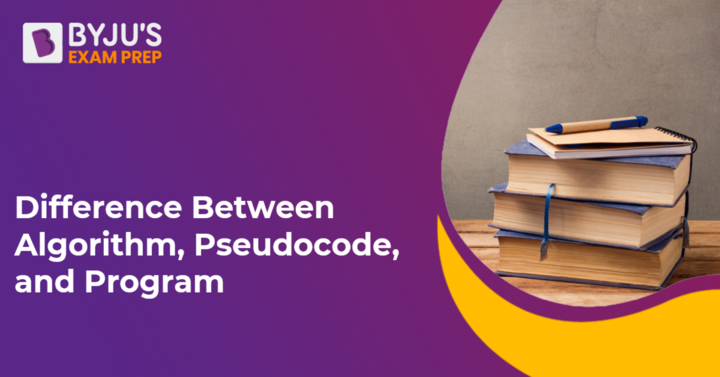Difference Between Algorithm, Pseudocode, and Program
By BYJU'S Exam Prep
Updated on: September 25th, 2023
Often, algorithm, pseudocode, and program are used interchangeably to refer to a source code, however, there exists a significant difference between algorithm, pseudocode, and program. In order to find a solution to a computer problem, we make use of algorithms, programs, and pseudocodes.
Difference Between Algorithm, Pseudocode, and Program PDF
In this article, we will be covering the difference between algorithm, pseudocode, and program. After looking at the difference between Algorithm, Pseudocode, and Program we will have a brief look at each one individually.
Table of content

Difference Between Algorithm, Pseudocode, and Program
It is evident how the algorithm is utilized to produce pseudocode, which is then expanded by following a certain programming language’s syntax to produce the program’s code. Now let us discuss and picturise the difference between algorithm, pseudocode, and program altogether for better understanding.
| Algorithm vs Pseudocode vs Program | ||
| Algorithm | Pseudocode | Program |
| Algorithms are typically written in natural language or plain English. | Pseudocode is written in a format resembling that of a high-level programming language. | The program enables us to write code in a certain programming language. |
| Algorithms can be expressed using flowcharts. | With pseudocode, you can add several control structures like repeat-until, if-then-else, while, for, and case. | A program cannot be read directly by a device. Instead, everything can be written in a computer language and then translated into a language that can be understood by any computer system using a compiler or interpreter. |
What is an Algorithm?
An algorithm is a sequence of finite steps to determine an output with zero or more inputs. It is a well-defined procedure. Before writing any source code for a problem we generally approach towards solution starting from an algorithm.
An algorithm is followed by a testing procedure which in turn is followed by writing a proper source code in programming language and implementation. One of the difference between algorithm, pseudocode, and program is that an algorithm is a systematic step-by-step procedure while the other two that is program and pseudocode may or may not follow step-by-step sequence to find a solution to the defined problem.
What is a Pseudocode?
Pseudocode refers to the manner in which an algorithm is designed or a way to represent an algorithm. They do not follow any specific syntax of any programming language. It is a simple representation of a programming code in plain English along with short phrases to write a code.
Pseudocodes are written using some familiar structures from programming languages like C, FORTRAN, etc. The difference between algorithm, pseudocode, and program includes that pseudocode is a representation of an algorithm. Most of the time algorithms are represented using pseudocodes as they can be read and understood easily by a programmer.
What is a Program?
A program is defined as passive and static. It follows the rules and syntax of a programming language. It is a systematic step-by-step syntactic representation of a solution to a problem. A computer in order to interact with humans uses programs as an interface. A program is a set of instructions for the computer to follow.
A program is written in a programming language and then compiled by a compiler or interpreted by an interpreter to make it computer understandable. A program can be written in any programming language following its syntax and other sets of rules.
Key Differences Between Algorithm, Pseudocode, and Program
The key difference between algorithm, pseudocode, and program are given below.
- An algorithm is well defined, systematic approach, a program is a set of instructions to be followed by a computer interpreter while pseudocode is a representation of an algorithm.
- An algorithm and pseudocode can be written in any programming language and are not the final codes to be executed by a compiler or an interpreter.
- A program follows a specific programming language and is compiled by it while an algorithm and pseudocode cannot be compiled.
- An algorithm can be expressed using flowcharts, and pseudocode can be represented using control structures while a program follows the proper syntax of a programming language.
| Other Important GATE Topics | |
| Difference between div and span | |
| Difference Between Mutable and Immutable | Difference Between Modem and Router |
| Difference Between Hard Copy and Soft Copy | |


